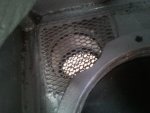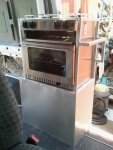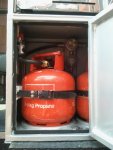noarlunga
Full Member
- Posts
- 264
- Likes
- 124
Hi Folks,
After having had a spirit hob (nicked from my boat as a temporary cooking facility) in my first van design I'm now installing refillable gas bottles and a Smev hob.
It's a MWB Transit van and due to extreme clutter under the van I've sadly had to rule out an underslung tank, partly because of room and partly because of weight distribution, the only possible space being behind the back axle.
So, the two small gas bottles are going into a purpose built cupboard within the kitchen unit itself. This is framed out in 2" x 1" wood and the initial thought is to clad it in 3mm oak faced ply for cosmetic purposes.
I need to provide a firebreak around the cylinders in order for the installation to meet regs and I'm not sure what might be acceptable. One solution would be to clad the inside of the frame with plasterboard, after all that's the firebreak on the ceilings of my house.
Another slightly more costly solution might be to fill the framed spaces behind the ply with fireproof board such as Skamotec 225 - Insulating fireboard heat proof 1000*C lightweight fire board fireplace lining | eBay
Any thoughts or alternative ideas would be welcome.
Johnny A
After having had a spirit hob (nicked from my boat as a temporary cooking facility) in my first van design I'm now installing refillable gas bottles and a Smev hob.
It's a MWB Transit van and due to extreme clutter under the van I've sadly had to rule out an underslung tank, partly because of room and partly because of weight distribution, the only possible space being behind the back axle.
So, the two small gas bottles are going into a purpose built cupboard within the kitchen unit itself. This is framed out in 2" x 1" wood and the initial thought is to clad it in 3mm oak faced ply for cosmetic purposes.
I need to provide a firebreak around the cylinders in order for the installation to meet regs and I'm not sure what might be acceptable. One solution would be to clad the inside of the frame with plasterboard, after all that's the firebreak on the ceilings of my house.
Another slightly more costly solution might be to fill the framed spaces behind the ply with fireproof board such as Skamotec 225 - Insulating fireboard heat proof 1000*C lightweight fire board fireplace lining | eBay
Any thoughts or alternative ideas would be welcome.
Johnny A



